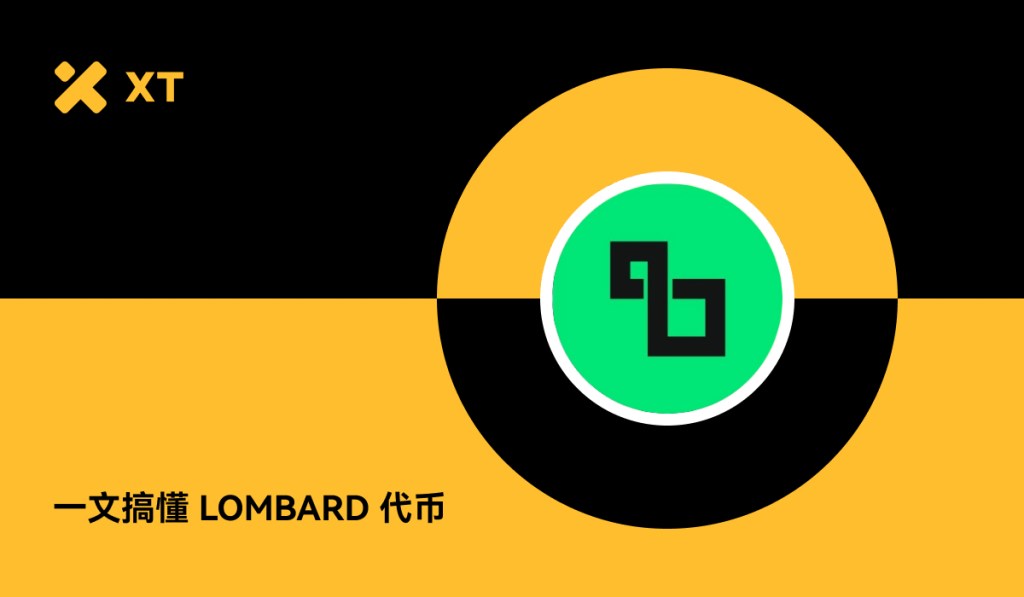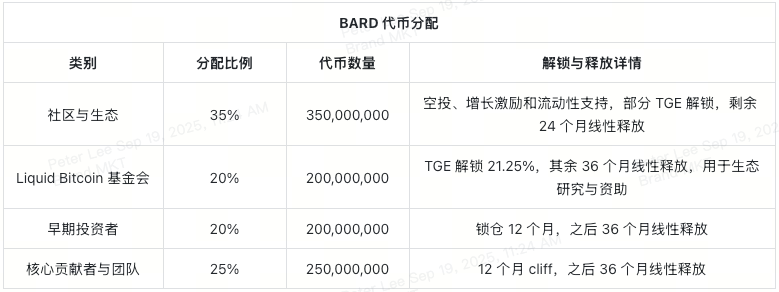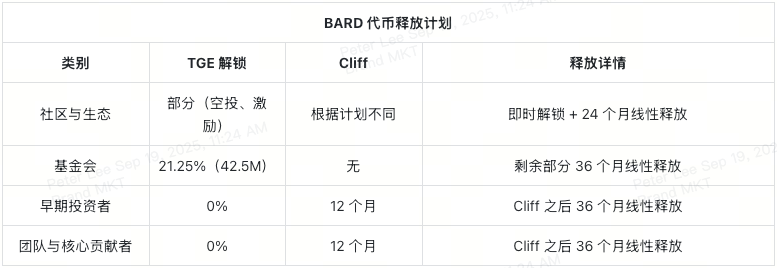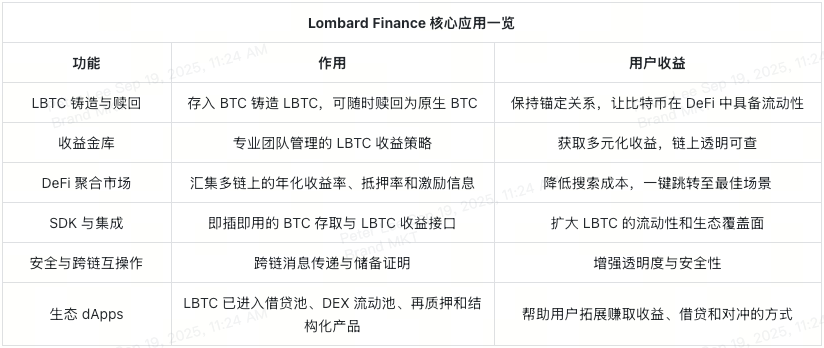Core Points
- Bitcoin Enters DeFi: Lombard Finance activates BTC liquidity through LBTC, a fully collateralized token that seamlessly connects to mainstream public chains and Layer 2 networks.
- Token Function: The BARD token drives governance, staking security, ecological funding support, and product usage permissions.
- Supply Mechanism: The total supply is capped at 1 billion, utilizing a long-term unlocking mechanism that includes community distribution and a buyback path determined by governance.
- Core Products: Includes LBTC minting and redemption, Bitcoin yield vaults, and cross-chain DeFi aggregation markets.
- Acquisition Channels: Users can participate through airdrops and purchase on spot markets such as the BARD/USDT trading pair on XT.com.

Everyone says Bitcoin is "digital gold," which is reliable for storing value. But if it only stays in this role, doesn't that mean many opportunities are wasted? Lombard Finance poses an intriguing question: What if BTC could also become the engine of DeFi?
The answer is LBTC. It is a 1:1 pegged token to Bitcoin that can circulate freely on mainstream public chains like Ethereum and Layer 2. Unlike traditional "passive" wrapped tokens, LBTC not only provides liquidity but also participates in earning yields, providing liquidity, and collateralization. The core of this mechanism is the BARD token—responsible for governance, cross-chain security, and supporting the expansion of the entire ecosystem.
For investors and developers, this means an imaginative opportunity: a truly usable bridge between the massive scale of Bitcoin and the innovative gameplay of DeFi. Next, we will take you through the underlying logic of Lombard Finance, how the BARD token operates, and why it may redefine Bitcoin's position in the DeFi world.
Table of Contents
Overview of Lombard Finance Project
BARD Token Economics, Distribution, and Buyback Mechanism
Core Applications and Ecological dApps of Lombard Finance
How to Participate and Acquire BARD Tokens
Competitive Landscape of Lombard Finance
Risks and Considerations of BARD Tokens
Overview of Lombard Finance Project
Lombard Finance is dedicated to unlocking Bitcoin's potential in decentralized finance, transforming idle BTC into active on-chain capital. The platform issues LBTC, a 1:1 token backed by custodial Bitcoin, which can be used in various DeFi scenarios such as lending, liquidity provision, and structured yields. The entire process is secured by an institutional-grade validator alliance, while Chainlink provides reserve proofs and cross-chain messaging to ensure transparency and reliability.
Operating Mechanism
– LBTC Core Asset: Users can mint LBTC by depositing Bitcoin and can redeem it at any time.
– Cross-Chain Integration: Integrated with mainstream public chains like Ethereum and Layer 2, covering the ecosystems with the most concentrated liquidity.
– Infrastructure Support: Based on Chainlink oracles and a secure custodial model, ensuring reserves are verifiable.
Developer and User Tools
Developers can use the software development kit (SDK) provided by Lombard to easily implement BTC deposits, LBTC minting, and yield integration. Regular users can operate through a web application, including one-click minting and redemption, yield vaults managed by professional teams, and aggregated market tools to help discover the best yield and collateral opportunities. Institutional users can also enjoy compliance and reporting support.
Role of BARD Token
BARD token is the coordinating core of the entire system. Token holders can participate in governance, stake to enhance cross-chain security, and decide on the allocation of ecological funds. As the ecosystem develops, governance can also initiate fee distribution and buyback mechanisms, linking platform growth with token value.
BARD Token Economics, Distribution, and Buyback Mechanism
BARD Token has a fixed total supply of 1 billion tokens. At the TGE (Token Generation Event), a portion of the tokens entered circulation, while the remaining tokens will be gradually released according to a multi-year linear unlocking plan to ensure a balance among long-term stakeholders. This design ensures early community participation while aligning the incentives of the team and investors through phased releases.

Distribution Highlights
– Community and Ecosystem: Used for airdrops, growth incentives, and partner support.
– Foundation: A large reserve of Bitcoin is set aside to fund developers, research, and ecological projects.
– Investors and Team: Long-term lock-up to ensure aligned interests.
– Liquidity and Incentive Pool: Provides market depth and promotes early adoption.

Use Cases of BARD Token
– Governance Rights: Token holders can vote on cross-chain parameters, fund allocation, and incentive plans.
– Security Staking: Supports cross-chain operations through staking and earns rewards.
– Ecological Development: Tokens are used to fund project integrations, developer incentives, and liquidity plans.
– Product Usage: Token holders can enjoy priority experiences or preferential terms for dApps and vaults.
Buyback and Value Transfer
Initially, no burn mechanism was designed. In the future, when the Lombard Finance platform generates fees from minting, redemption, vaults, and on-chain transactions, the governance layer can decide to use a portion of the income for open market buybacks. The repurchased tokens may:
– Be distributed to stakers
– Flow back to the vault
– Or be directly burned to reduce circulation
This way, value capture remains community-governed.
Core Applications and Ecological dApps of Lombard Finance
Lombard Finance offers a continuously expanding range of applications aimed at providing Bitcoin with liquidity, yield generation, and security in DeFi. All products together form a cycle: BTC deposits, LBTC circulation, yield accumulation, and deepening liquidity.

LBTC Minting and Redemption
Users can mint LBTC at a 1:1 ratio by depositing Bitcoin. A consortium of multiple institutions is responsible for verifying custodial conditions, and the reserve proof provided by Chainlink ensures that each LBTC is fully backed by BTC. During redemption, the process is executed in reverse, allowing users to retrieve their native BTC at any time. This bidirectional mechanism supports arbitrage and helps maintain LBTC's stable peg.
Yield Vault
Lombard's yield vault will invest LBTC into diversified strategies, including lending markets, liquidity pools, and yield optimization protocols. The vault is managed by a professional team, with on-chain proof being transparent and verifiable, allowing users to track performance and exit flexibly at any time. Yields will be dynamically adjusted based on market conditions and will have relevant fees deducted.
DeFi Aggregation Market
The built-in market on the platform aggregates LBTC use cases across multiple chains. Users can quickly view lending rates, collateral parameters, and liquidity incentives on a single panel, and jump directly to lending similar to Aave, yield trading like Pendle, or stablecoin lending with one click. This significantly reduces the cost of finding efficient LBTC applications.
SDK and Integration Tools
For developers, Lombard provides an SDK that allows for quick implementation of native Bitcoin deposits, LBTC minting, and yield integration. Wallets, exchanges, and applications can connect at low cost, and each new integration can increase LBTC's liquidity and usage scope.
Security and Cross-Chain Interoperability
Cross-chain communication operates on mature production-grade infrastructure, with reserve proofs ensuring that LBTC is always fully collateralized. The governance layer can also flexibly adjust the validator composition, staking rewards, and fee structures, continuously enhancing system security.
Ecological dApps
In addition to official applications, LBTC has also entered lending markets, DEX liquidity pools, re-staking frameworks, and structured products. Developers can also design new products based on LBTC, such as BTC basis vaults, options strategies, or stablecoin collateral modules. For users, this means more ways to earn, hedge, and lend, all utilizing Bitcoin exposure directly in DeFi scenarios.
How to Participate and Acquire BARD Tokens
There are multiple ways to acquire BARD tokens, whether through early allocations, trading on exchanges, or directly via DeFi.
Step 1: Check Eligibility and Claim
If you interacted with LBTC before the snapshot date, you may be eligible to claim.
– Visit the official BARD claim page
– Carefully review the allocation batch schedule
– Note the deadline to avoid missing unclaimed shares
Step 2: Exchange Channels
Centralized exchanges (such as XT.com) have launched the BARD/USDT spot trading pair, allowing users to buy and sell directly.

Step 3: On-Chain Liquidity
After launch, decentralized exchanges will gradually form BARD liquidity pools.
– Confirm the official contract address
– Assess the pool depth and potential slippage
– Use aggregators to improve trading efficiency
– It is recommended to start with small test trades to ensure accuracy
Step 4: Staking and Practical Scenarios
Holding BARD is not just for trading; it also unlocks more functionalities:
– Stake tokens to support cross-chain operations
– Gain governance rights, fee tier discounts, and vault incentives
– Follow the governance forum to stay updated on token emissions, buybacks, or incentive plan changes
Security Reminder: Always operate through official links, carefully verify token symbols, and use hardware wallets to enhance security when necessary.
Lombard Finance Competitive Landscape
In the exploration of bringing Bitcoin into DeFi, Lombard Finance faces competition from various models. Each solution has its trade-offs in terms of custody methods, decentralization, liquidity, and availability.

Core Summary
– WBTC holds a liquidity advantage but has gaps in decentralization and yield design.
– Threshold Bridges are more aggressive in decentralization but have limited scale and integration.
– Stacks and Rootstock expand Bitcoin's programmability but lack liquidity.
– Lombard Finance combines distributed custody, on-chain reserve proofs, multi-chain coverage, and yield-oriented design, while providing governance and funding support through the BARD token, accelerating ecosystem expansion.
BARD Token Risks and Considerations
Like any cross-chain bridge or staking system, Lombard Finance has certain risks that investors need to evaluate carefully.
Custody and Technical Risks
– The security of LBTC relies on the performance of custodians and validating nodes. Failures, triggering of penalty mechanisms, or operational errors may affect the underlying asset support.
– The cross-chain structure itself is complex, which may introduce smart contract vulnerabilities, and temporary de-pegging may occur under market pressure.
Regulatory and Market Risks
– The global regulatory environment is constantly changing, which may affect the compliance of custodians, exchange listing arrangements, and even the implementation of fee distribution mechanisms.
– New tokens often have insufficient liquidity in early trading, and unlocking plans may exert selling pressure on the market, potentially leading to valuations deviating from fundamentals.
Governance Risks
As the tokens of the team and early investors gradually unlock, voting power may become concentrated. Therefore, how to balance the power between the community and internal holders is a key focus that requires ongoing attention.
Risk Management Recommendations
1. Obtain links through official channels and carefully verify contract addresses and token codes.
2. Initially participate with small amounts and gradually increase positions.
3. Treat vault yields as variable income and pay attention to changes in governance forums regarding releases, buybacks, or fee structures.
Lombard Finance Outlook
Lombard Finance is positioning itself as a key infrastructure for Bitcoin's entry into DeFi. Its approach is clear: to unlock BTC liquidity, bring it to chains that users are already familiar with, and coordinate the long-term development of the ecosystem through the BARD token.
Short-Term Signals
– Pay attention to the launch of new trading pairs, such as the BARD/USDT spot market.
– Vault products will continue to expand, providing users with richer yield strategies.
– Partner integrations are expected to further amplify LBTC's role in lending and collateral markets.
Mid-Term Development
The governance layer may initiate fee switches and structured buyback plans, bringing direct value back to the token economy. This will be an important phase to test how the community manages incentives and funds.
Long-Term Potential
If Lombard Finance can continue to improve in liquidity, ecosystem integration, and decentralization of cross-chain bridges, it has a real opportunity to become the industry standard for Bitcoin liquidity entering DeFi. The BARD token will serve as the coordinating engine for the entire system.
Frequently Asked Questions: About Lombard Finance and BARD Tokens
Q1: What is LBTC? How is it related to LOMBARD?
LBTC is a Bitcoin-pegged token minted through Lombard Finance, with each token backed 1:1 by real BTC. BARD is the governance and functional token used to secure and promote the development of the entire ecosystem.
Q2: How can I acquire BARD tokens?
Currently, you can acquire them through airdrops, the BARD/USDT spot trading pair on XT exchange, and gradually opening decentralized exchange liquidity pools.
Q3: How does Lombard Finance differ from WBTC or other Bitcoin-wrapped tokens?
Lombard employs distributed custody, on-chain reserve proofs, and supports yield strategies, making LBTC truly productive; whereas WBTC relies on a single custodian and cannot generate yields.
Q4: What risks should I be aware of?
Main risks include: custody security, cross-chain smart contract vulnerabilities, regulatory policy changes, and potential market volatility in early trading of new tokens.
Q5: How does the BARD token achieve value capture?
Community governance can decide the direction of protocol fees, including buybacks, vault reserves, or allocations to stakers, ensuring that incentives align with ecosystem growth.
Q6: Where can I learn more about Lombard Finance?
You can visit the official website, technical documentation, or join official community channels (X, Discord, Telegram) to check token economics, governance proposals, and integration guides.
About XT.COM
Founded in 2018, XT.COM currently has over 7.8 million registered users, with over 1 million monthly active users and user traffic exceeding 40 million within the ecosystem. We are a comprehensive trading platform supporting 1000+ quality coins and 1300+ trading pairs. XT.COM cryptocurrency trading platform supports a rich variety of trading options including spot trading, margin trading, and futures trading. XT.COM also has a secure and reliable NFT trading platform. We are committed to providing users with the safest, most efficient, and professional digital asset investment services.
免责声明:本文章仅代表作者个人观点,不代表本平台的立场和观点。本文章仅供信息分享,不构成对任何人的任何投资建议。用户与作者之间的任何争议,与本平台无关。如网页中刊载的文章或图片涉及侵权,请提供相关的权利证明和身份证明发送邮件到support@aicoin.com,本平台相关工作人员将会进行核查。




